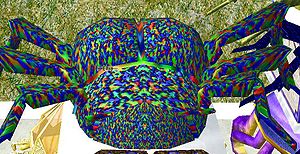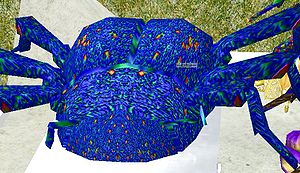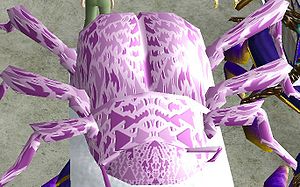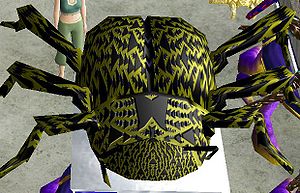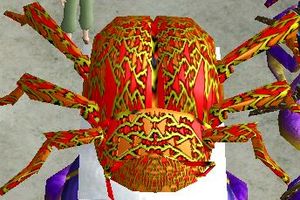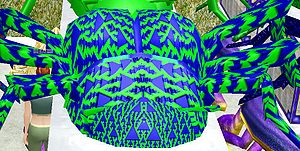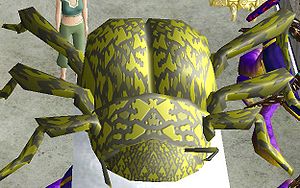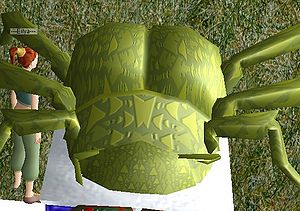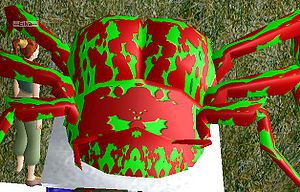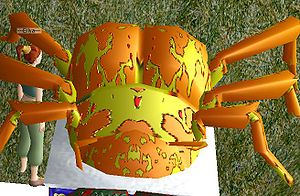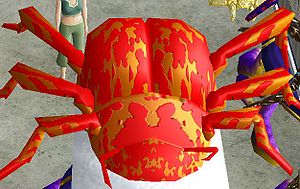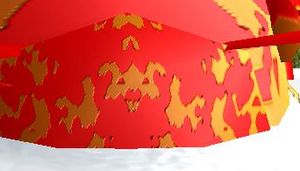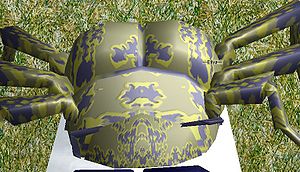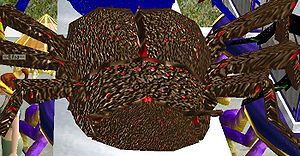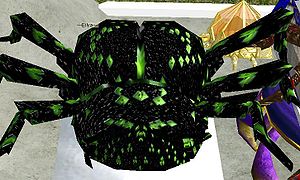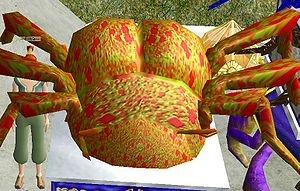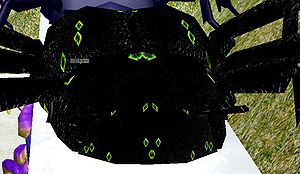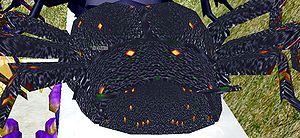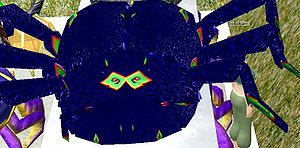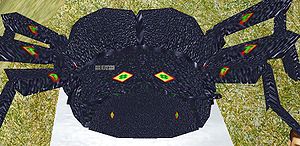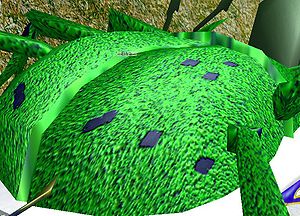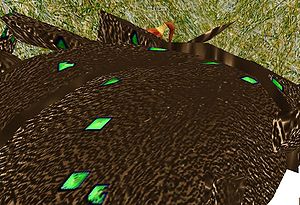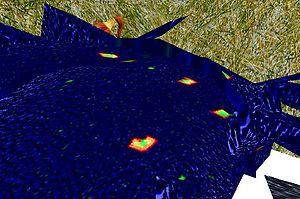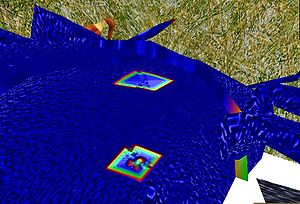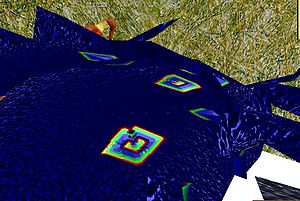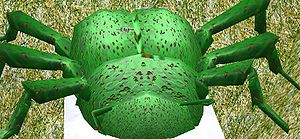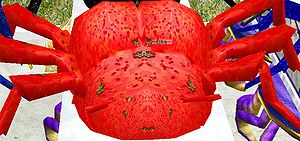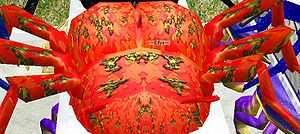The Wiki for Tale 6 is in read-only mode and is available for archival and reference purposes only. Please visit the current Tale 11 Wiki in the meantime.
If you have any issues with this Wiki, please post in #wiki-editing on Discord or contact Brad in-game.
Difference between revisions of "User:Eilya/BeetleBreedingThoughts"
| Line 123: | Line 123: | ||
[[File:DiamondResolution2.JPG | 300px | The Diamond Mutates into a more Detailed Motif and the Skin Clarifies]] | [[File:DiamondResolution2.JPG | 300px | The Diamond Mutates into a more Detailed Motif and the Skin Clarifies]] | ||
[[File:DiamondResolution3.JPG | 300px | The Diamond Mutates into a more Detailed Motif and the Skin Clarifies]] | [[File:DiamondResolution3.JPG | 300px | The Diamond Mutates into a more Detailed Motif and the Skin Clarifies]] | ||
| + | |||
| + | |||
| + | == Exotic Motifs == | ||
| + | |||
| + | These rather exotic motifs came from advanced Curls that I forced into mutation. The first stage of the mutation was the spots appearing on a 3 colour Curl design, this was a VERY strong pattern, it replicated almost perfectly no matter where I bred it. I finally put ten almost identical bettles with that design and a very weird mutation appeared (that I didn't photograph sadly) that was like a reddish/white beetle that had ben stabbed several times and still had open wounds. I left this mutation in with the ten identical ones to see what would happen, and it went through a series of mutations into the red beetle below with the gashes on. I was finally able to breed this with some smooth plain beetles to get the 3rd picture below. | ||
| + | |||
| + | [[File:Beetle_CurlMutation1.JPG | 300px | The Curl Mutation that was Highly Resistant to Change]] | ||
| + | [[File:Beetle_MotifFromCurl1.JPG | 300px | The Motif Mutates into a very Exotic Pattern]] | ||
| + | [[File:Beetle_MotifFromCurl2.JPG | 300px | The Motif Becomes Clearer when Bred with Plains]] | ||
Revision as of 15:49, 24 July 2013
Eilya's Thoughts on Beetle Breeding
I started my beetle breeding from scratch with a few wild beetles (one of each of Burrowing, Speckled and Plains). I also added some wild beetles from my alt Iril, and we both worked the tanks for a while, so my beetles are the product of two avatars. I don't know to what extent this has affected my results.
The long-standing guide says to setup MPT (Male Pattern Tank - 2F, 9M) and FPT (Female Pattern Tank - 2M, 9F) but doesn't really say WHY. I read it lots of times trying to see what it was getting at, and in the end decided to just do my own thing. From experience I think the WHY is the following:
1) A ratio of greater than 4:1 gives a high likelihood of breeding talking place by the pair of males or females you are using.
2) With only 2M or 2F in one tank it is easier to see what breeding takes place.
I still haven't decided why they go for 9 plain colour etc, as I have not yet seen a truly plain colour, everything I have has a subtle pattern underneath, even if it is the same colour, and this affects the outcome. Maybe this will come later on as my beetles designs become purer. For this reason I found it better to work with a mix of males and females of the same pattern - UNLESS I was trying specifically to move a pattern onto one colour.
My approach to breeding has been to have 10+ beetles in a tank of similar pattern and try to "push" the pattern in the direction I wanted. The way I did this was to cull/remove any new beetle that didn't go towards the pattern I wanted. Selective breeding so to speak.
Things I have seen are documented below.
Ownership
Any wild beetle is "not owned". When you place a beetle in a Terrarium it will change to 100% Owned (by you), anyone else viewing that beetle will see it as 0% Owned (by them).
A 100% owned male and a 100% owned female will ALWAYS produce a 100% owned offspring. This means it is impossible to progress in principles without obtaining a beetle that has been in another players Terrarium, as you will only breed low % beetles by breeding with their beetle, which will start off as 0% owned (by you).
I also suspect that ownership plays a part in speed of mutation, as I have observed beetles with ownership in the 90's mutating less (ie having a stronger tendency to produce similar offspring, or even almost perfect copies). If this is the case it will be helpful when trying to perfect a nice pattern, as at that stage you want the pattern to be relatively stable. Elsewhere I have read that "certain patterns are resistant to mutation", so it could merely be that my >90% beetles that mutate slowly were of these strains, if I see any more evidence I will write further about this.
Clearing
With early beetles (and I also suspect with some of the chaotic muddles that emerge later on) there is a layer of "crud" over the beetle sometimes. In very early breeds I often got a layer of black horrible "skin" striated across the beetle. Successive generations had less and less of this crud until it finally disappeared altogether, or mutated into a nice vivid colour. This appears to be some sort of "clearing" of the genetic material. Odd types of crud re-appear later on after a nice pattern has mutated and I suspect this will also clear, but do not know for sure yet.
I have also noticed that an early mutation into 6 or 7 colours spread all over a beetle, will often slowly change into a 2 or 3 colour beetle, with a distinct motif (such as a Diamond) containing the remaining colours. In other words the distinct motif is somehow spread across the rest of the beetle and distorted, making it hard to see that there is any pattern. You can also see this in reverse when a distinct motif starts to break up, or has so many instances of the motif, so as to cover the body of the beetle, and starts to distort.
With some offspring it is clear that the pattern and colour are identical, but the viewpoint is merely zoomed in or altered, so in addition to the fractal nature of the patterns that others have posited I would posit an imagined viewpoint and distance from the object, and some kind of physical distortion or wrapping of the object, such as might be seen on a sphere or balloon that has inflated or deflated. This idea and the layering idea help me think about the breeding process in a structured way, rather than everything being entirely random. It could, of course, have absolutely nothing to do with the way things are actually generated...
The pictures of the Mandlebrot fractal at different magnifications in Wikipedia really helped me understand this a bit better: | Wikipedia Fractals Page. As I spent more time trying to breed patterns, particularly Diamond motifs I saw this with very clear motifs that were travelling up and down the continuum of magnification form smooth skinned with sharp, crisp, shaped motif but no colour or texture up to very rough skinned with lots of colour and texture to the motif but little definition. Having seen advanced beetles on display I know that continued breeding will lead to a very focussed motif that is both crisp and has colour.
Mutation
A pattern seems to mutate best when 8 to 10 beetles of a very similar pattern and colour are together, less so when many other different strains are present. Whether this is just more obvious when this is so, or whether it is a genuine rule I don't know. But it is the case.
When a mutation occurs the pattern changes dramatically, may become chaotic, often develops a startlingly different colour, and may even increase the number of colours present.
Sometimes the beetle will mutate directly into a definite design, like a Triangle or Diamond motif, others it will mutate into a choatic strain which contains the motif that will gradually emerge as it breeds. (For instance a dot on an otherwise plain beetle that grows into a diamond shape).
When mutation does not occur the offspring can be clearly seen to be a product of its parents, having a similar pattern, colour or hue as one or both of the parents.
After several generations mutations can sometimes clearly be seen to be throw-backs to previous patterns you have grown. This led me to believe that some kind of genetic history is held on a beetle, although it may be more of a genetic timeline, and the beetle mutates up and down the timeline. We will see...
Below are some examples of mutations and how they transform.
This is a 7 colour mutation that appeared, the beetle next to it is several generations later showing how the colours coalesce and the pattern transforms. This is going to be some kind of Diamond motif, hopefully with an interesting pattern inside the Diamond.
Geometric Shapes
Triangles
Triangles were the first obviously geometric shape I met. It arose first out of a mutation that I was calling "Waspy" which was a vivid pattern of several colours that reminded me of a wasp. This eventually mutated into sets of triangles on a clear plain background. There is still variation in the pattern, how much it "protrudes" from the plain colour below, the ratio of the colours, but several things stood out.
There are 3 layers of colour, sometimes 3 hues of the same colour (ie 3 different greens) and sometime 3 distinct colours that seem to have a relationship to each other (like opposites etc). A plain background and two triangles of different colours is the norm, although they can quite often be very close in hue, so as to become a single colour overall. This led me to see a sort of layering, both of pattern and colour at times.
ZigZags
Triangles are the easiest shape to direct. I found that they tend to either diverge or converge in offspring. If you continually cull the diverging triangles, and leave the converging ones they will become a pattern I call "Lines" where the triangles overlap so much that only lines are left of the shape. Continue with this process and the background colour will actually become the dominant shape, as it forms wide, zigzagging lines. I call this pattern ZigZags, even though large triangles may still be present.
Curls
If you cull the converging triangle and leave the diverging ones they will start to break up and mutate into curly edged shapes, sometimes a bit like cogs, this progresses to very large curly shapes on a plain background, or single colour beetles with a very delicate hint of curls underneath.
More Advanced Shapes
Diamonds
I haven't been working with the Diamond motif for as long, and am still working out its vagaries. The Diamond motif appears as a mutation of an advanced Triangle pattern. Whenever it has first appeared for me it has always been with a very rough textured skin and small coloured blobs, which I originally dismissed as throw-backs to a burrowing/speckle cross-breed of some sort. An extended period logged off (24hr) allowed them to transform further and I could see the Diamond motif developing.
I haven't had much luck transferring this motif yet. As you will see below, when I breed it with plainer skins it loses its colour and becomes a very plain shape. However, when I continue to breed it in its "rough" skin it starts to become a much more defined image within the Diamond shape itself. I can make these larger and smaller, and also completely cover the beetle with them, but I have not yet found a way to isolate one Diamond or place it on a nicer background. I am hoping that the rough skin is similar to the crud I found on very early beetles that later "cleared".
I am working on Green/Grey and Red/Blue versions of the Diamond motif at the moment, and will update the blog if I gain any success.
These two images are a few days later showing how the Diamond image sharpens and starts to reveal inner patterns, and also how its colour mutates.
A day or so later I am still struggling to change the rough skin on Diamond patterns. Any attempt to breed it with a smooth skinned beetle leads to a flat single colour diamond that completely lacks "depth" (like the red one above). I am beginning to suspect that I will need to take these smooth beetles with "flat" diamonds and re-mutate them, it is almost as if the diamonds are on a different "layer" that is not as mutated, so it lacks detail.
I am starting to gain better results within the diamond pattern itself, as you can see below.
And I swear the second one got much sharper over several hours AFTER it was born. I didn't think they could change in that way, so I may just have overlooked it, but it is the sharpest image I have got yet, so I don't know how I could. It appears to have sharpened long after it had been named, but this probably speaks more about what happens to you when you start staring at beetles!
After another day I am starting to better understand the way the Diamond mutates and clears. I went back to one of the Diamonds that I bred out with a plainer beetle when trying to get rid of the "rough skin". I said before that I suspected they were on a different, or more plain, level and would need to be re-mutated, and it looks like I was right. Below is the cross-breed pattern, and next to it a mutation of that pattern, which has gone back to the "rough skin" but with a clearer Diamond motif.
I also started to see how pushing the Diamond pattern itself causes a different sort of mutation. It clarifies the image inside the diamond, and at the same time starts to smooth the rough skin. The effect is similar to changing your screen to a higher resolution, so I suspect there is an element of texture resolution being used. This is good news, as it means I don't need to cross-breed the Diamonds to get rid of the "rough skin", it will clarify itself as it mutates. (I now rush back to breed and mutate those vivid red and violet rough skins I thought were useless!)
Exotic Motifs
These rather exotic motifs came from advanced Curls that I forced into mutation. The first stage of the mutation was the spots appearing on a 3 colour Curl design, this was a VERY strong pattern, it replicated almost perfectly no matter where I bred it. I finally put ten almost identical bettles with that design and a very weird mutation appeared (that I didn't photograph sadly) that was like a reddish/white beetle that had ben stabbed several times and still had open wounds. I left this mutation in with the ten identical ones to see what would happen, and it went through a series of mutations into the red beetle below with the gashes on. I was finally able to breed this with some smooth plain beetles to get the 3rd picture below.
